
What is brake fluid and how to check it
Content
- What is brake fluid and what are its functions
- Brake master cylinder
- Brake fluid requirements
- How does brake fluid “age”?
- How often do I need to check the brake fluid in the car?
- Checking the brake fluid level
- Reasons to check brake fluid
- How to check the properties of brake fluid?
- How to change brake fluid?
- How often do I need to change brake fluid?
Car maintenance involves a whole list of manipulations. One of which is the change and check of the brake fluid (hereinafter referred to as TJ). This fluid is needed in order for the brake system to work properly.
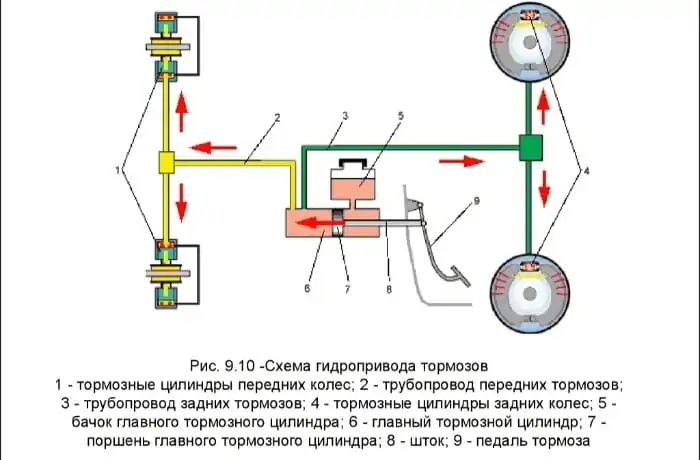
TJ performs an important function - transferring the force of pressing the brake pedal to the working cylinders of the brake system. That is, when the driver presses the brake pedal, the fluid through the brake system tubes is delivered from the main cylinder to the brake drums or discs, during which, due to friction, the car slows down.
If the driver does not change the brake fluid in time, all components of a single mechanism will fail. This will directly affect driving safety.
What is brake fluid and what are its functions
The brake fluid in the car transmits the pressure force from the GTZ (brake master cylinder) to the brake mechanisms of each wheel. The physical properties of liquids allows their use in closed circuits for the instantaneous transfer of force from one end of the line to the other.
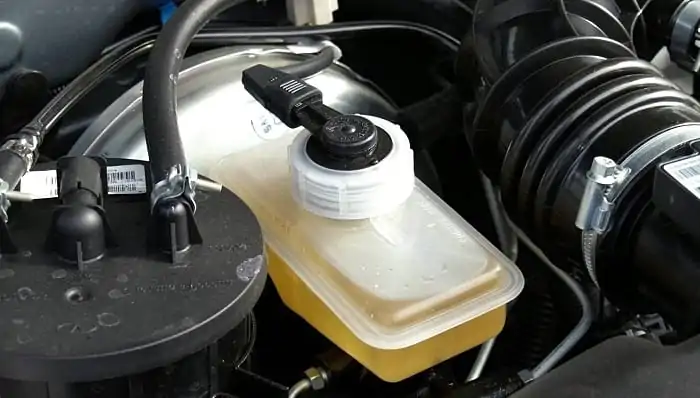
The brake system of the car consists of:
- brake mechanism;
- brake drive (hydraulic, mechanical, electric, pneumatic and combined);
- the pipeline.
Most often, budget and middle class cars are equipped with a hydraulic brake system, the highway of which is filled with TG. Previously, butyl alcohol and castor oil were used for this. They were mixed in equal proportions.
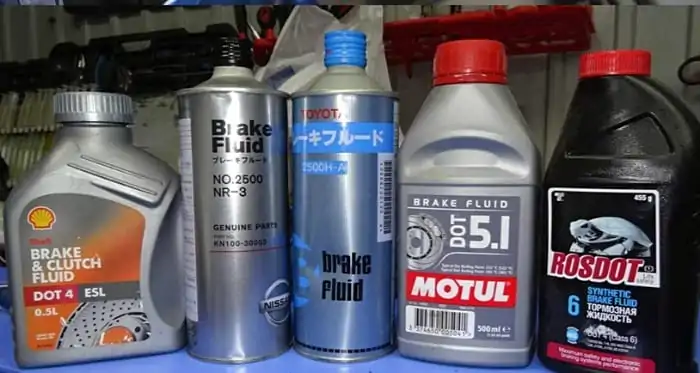
Modern liquids are 93-98 percent composed of ether polyglycols. To increase the efficiency and reliability of their products, manufacturers use various additives. Their number does not exceed 7%. Sometimes, silicones are taken as the basis for such substances.
Brake master cylinder
The hydraulic brake system is equipped with a brake master cylinder. This part is mounted on a brake servo. GTZ modern cars two-section. In front-wheel drive and rear-wheel drive cars, the system works in different ways.
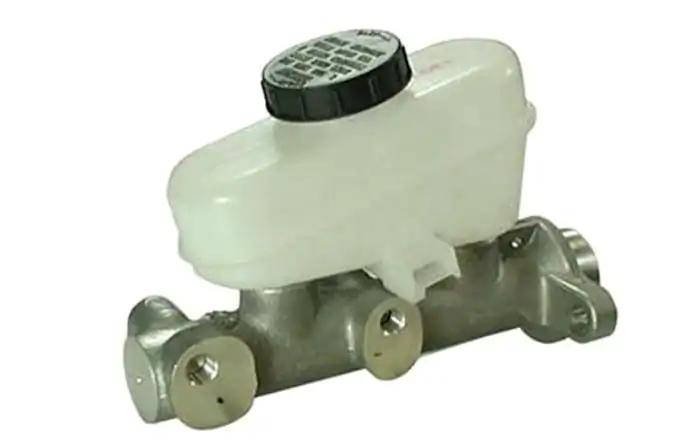
- Front-wheel drive. Most often, there are two circuits in such cars: one combines the brakes of the wheels of the right side, and the other of the left side.
- Rear drive. One circuit connects the brakes of the rear wheels, and the other - the front.
Two sections of the GTZ and the presence of two different circuits are created for safety. If there is a leakage of TJ from one circuit, then the braking mechanisms of the other will work. Of course, this will noticeably affect the movement of the brake pedal (free play increases until the moment of response), but the brakes will not disappear completely.
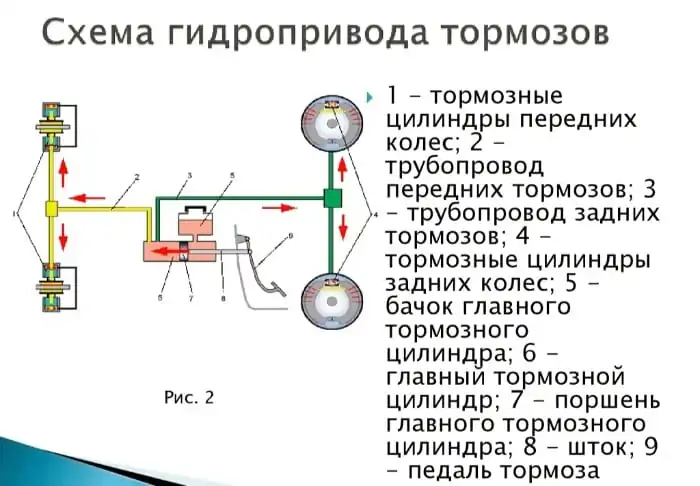
The main brake cylinder device includes:
- Body. On top of it is a tank with a reserve of TJ.
- Storage tank. It is made of transparent plastic, so that you can control the level of the liquid without opening the lid. For convenience, a scale is applied to the walls of the tank, which makes it possible to control even minor volume losses.
- Level sensor TJ. Located in the tank. If the level drops critically, the control lamp lights up (not all car models are equipped with such an alarm).
- Pistons. They are located inside the GTZ one after another according to the “train” principle. Both pistons are spring loaded to automatically return to their original position after braking.
- The stem of the vacuum amplifier. It drives the first piston, then the forces are transmitted to the second through the spring.
Brake fluid requirements
For safety on the road, each car must be equipped with a reliable brake system. To fill it, you must use a liquid with a special composition. It must meet the requirements for:
- boiling point;
- viscosity;
- impact on rubber parts;
- effect on metals;
- lubricating properties;
- hygroscopicity.
Boiling temperature
During the operation of the brakes, the fluid filling the system becomes very hot. This is due to heat loss from the brake discs and pads. Here are the average calculations of the temperature regime of TJ, depending on driving conditions:
| Drive Mode: | Liquid heating to toC |
| Track | 60-70 |
| City | 80-100 |
| Mountain road | 100-120 |
| Emergency braking (several presses in a row) | Until 150 |
If the circuit is filled with ordinary water, then at this temperature, it will quickly boil. The presence of air in the system is critical for the proper operation of the brakes (the pedal will fail), therefore, substances that increase the boiling threshold should be included in the TJ.
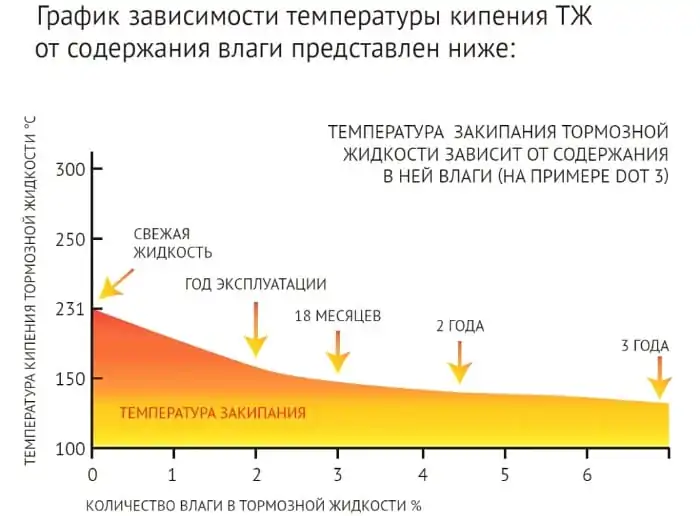
The liquid itself is not liquefiable, due to which there is an exact transfer of pressure from the pedal to the brake mechanisms, but when boiling in the circuit, small bubbles form. They force a certain amount of fluid back into the tank. When the driver presses the brake, the pressure in the circuit increases, the air in it is compressed, which makes the brake mechanisms not so tightly press the pads to the drum or disk.
Viscosity
Since the stability of the brake system depends on the fluidity of a substance, it must retain its properties not only when heated, but also at low temperatures. In winter, the brake system should work with the same stability as in the summer.
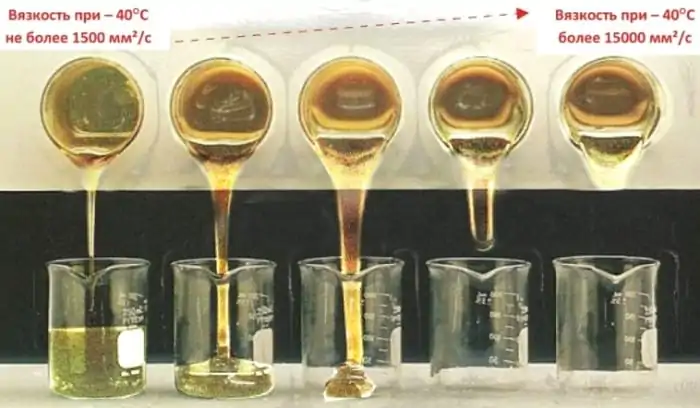
Thick TJ is pumped more slowly through the system, which significantly increases the response time of the brake mechanisms. At the same time, it must not be allowed to be very fluid, otherwise it will cause leaks at the junctions of the circuit elements.
Table of viscosity index of substances at a temperature of +40 toC:
| Standard: | Viscosity mm2/from |
| SAE J 1703 | 1800 |
| ISO 4925. | 1500 |
| DOT3 | 1500 |
| DOT4 | 1800 |
| DOT4 + | 1200-1500 |
| DOT5.1 | 900 |
| DOT5 | 900 |
At subzero temperatures this indicator should not be more than 1800 mm2/from.
Effect on rubber parts
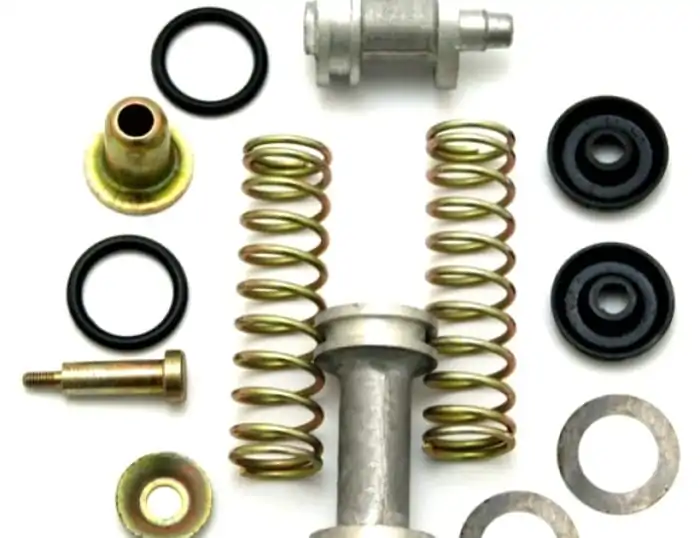
During the operation of the brake system, elastic seals must not lose their properties. Otherwise, coarse cuffs will prevent the pistons from running freely or let the TZ pass. In any case, the pressure in the circuit will not correspond to the desired indicator, as a result - inefficient braking.
Effect on metals
Brake fluid must protect metal parts from oxidation. This can lead to a violation of the mirror of the inner part of the brake cylinder, which will result in leakage of fluid from the working cavity between the piston cuff and the wall of the shopping center.
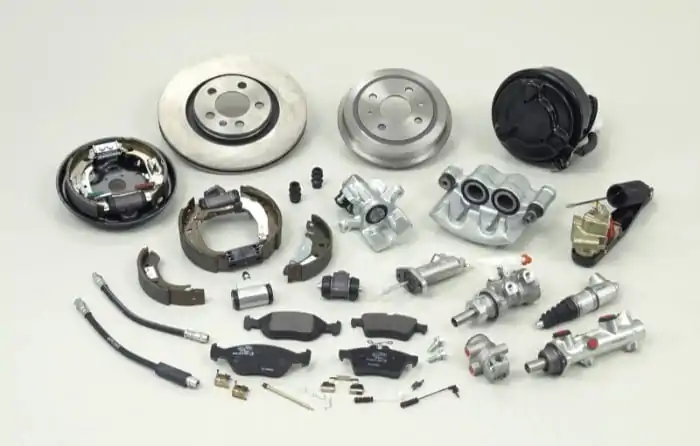
The resulting irregularities can lead to premature wear of rubber elements. A similar problem contributes to the appearance of foreign particles (pieces of rubber or cracked rust) in the line, which will affect the efficiency of the hydraulic drive.
Lubricating properties
Since the effectiveness of car brakes depends on the quality of the moving parts included in their device, they require constant lubrication for smooth running. In this regard, in addition to the properties listed above, TJ should prevent scratches on the mirror of work surfaces.
absorbability
One of the disadvantages of technical fluid in this category is the ability to absorb moisture from the environment. The boiling point (“wet” or “dry” TJ) directly depends on the amount of water in the liquid.
Here is a comparison table for the boiling points of both fluid options:
| Standard TJ | “Dry” boils at toC | “Wet” (amount of water 2%), boils at toC |
| SAE J 1703 | 205 | 140 |
| ISO 4925. | 205 | 140 |
| DOT3 | 205 | 140 |
| DOT4 | 230 | 155 |
| DOT4 + | 260 | 180 |
| DOT5.1 | 260 | 180 |
| DOT5 | 260 | 180 |
As you can see, even with a slight increase in the level of moisture (within two to three percent), the boiling point moves 65-80 degrees lower.
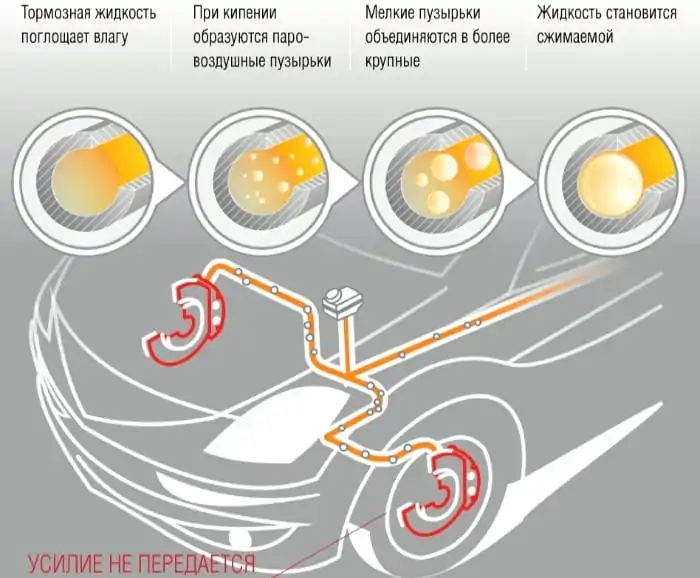
In addition to this factor, moisture in TJ accelerates the wear of rubber parts, leads to corrosion of metal elements, thickens more strongly at low temperatures.
As you can see, the brake fluid of motor vehicles must meet high requirements. That is why every motorist should be attentive to the recommendations of the manufacturers, choosing a TG for replacement.
How does brake fluid “age”?
The most common is the DOT4 brake fluid. This substance has significant absorbing properties, so manufacturers recommend periodically checking its composition and replacing it every 40-60 km. mileage. If the car rarely drives, then the system should be serviced after two to three years.
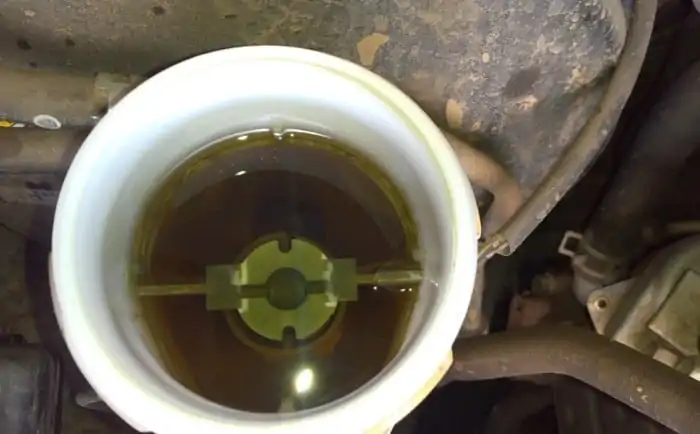
In the composition of the liquid fuel, the percentage of humidity may increase and foreign particles may appear (the speed of this process depends on the operating conditions of the car). The presence of the second can be noticed during visual inspection - the liquid will be cloudy. This is due to the natural wear of rubber parts and the formation of rust (if the owner of the car often ignored the recommended replacement regulations).
It is impossible to notice an increase in the humidity level visually (under different conditions, this process occurs at its own speed), therefore it is recommended to periodically check this indicator using a special tester.
How often do I need to check the brake fluid in the car?
Many motorists do not understand that car care is needed first of all for himself. Experts strongly recommend checking the level of brake fluid and its quality. If you neglect this advice - the brake system becomes dirty.
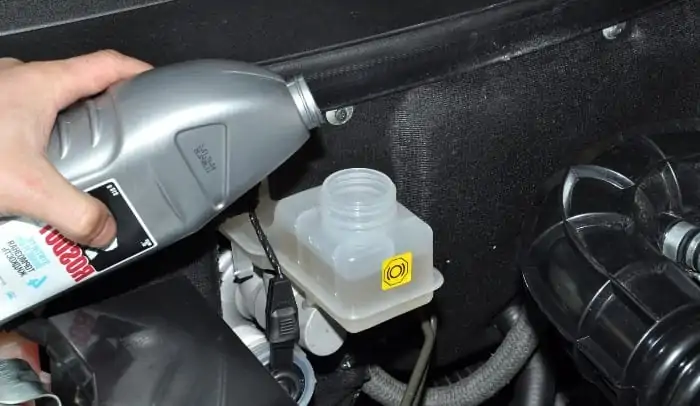
It must be understood that the quality of the “brake” is influenced by many factors: climatic properties, moisture content in the environment, condition of the brake system.
To avoid troubles on the road, check the brake fluid twice a year, and its level - once a month (more often).
Checking the brake fluid level
And so, as we already wrote, you need to check the brake fluid level once a month. Moreover, this procedure does not take much of your time.
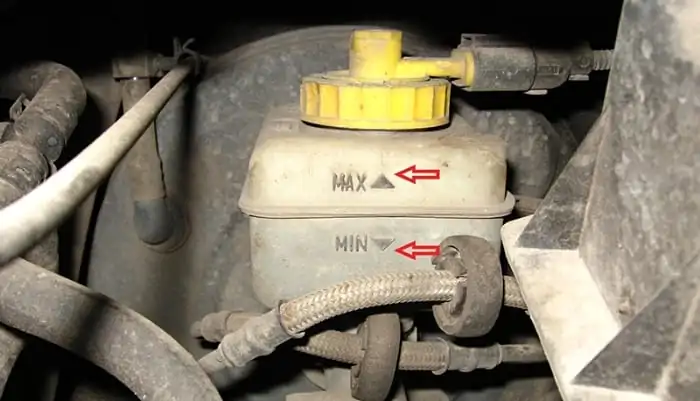
The first sign of a low level of “brake” is a sharp failure of the brake pedal. If the driver notices too soft pedal travel, you need to stop the car and check the level of TJ:
• Open the hood of the machine. Do this on a flat surface so the values are clearer.
• Locate the brake master cylinder. Most often, it is installed in the rear of the engine compartment, on the driver's side. You will notice a reservoir above the cylinder.
• Check fluid level. In most modern cars, and in Soviet ones too, this tank is transparent and has “min” and “max” marks on it. The TJ level should be between these marks. If your car was manufactured before 1980, this reservoir may be metal (not transparent). This means that you have to remove its metal cover to determine the level of the available liquid.
• Add fluid to the reservoir if necessary. Refill the TZ carefully. If your hand trembles and you spill liquid, wipe it off immediately, as it is toxic and corrosive.
• Replace the reservoir cover and close the hood.
Reasons to check brake fluid
Over time, the “brake” changes its properties, this leads to a deterioration in the operation of the entire brake system. No need to look for reasons to check TJ. But for those who are trying to find them, we provide a small list:
• "brake" picks up moisture and gets dirty. If it is more than 3%, all the beneficial properties of the liquid will be lost.
• the boiling point drops (this leads to the "disappearance" of the brakes)
• the likelihood of corrosion of brake mechanisms
It must be understood that replacing brake fluid is just as important as replacing engine oil or coolant. Therefore, when buying a car, get ready for the fact that after 2 years of operation, it is worth replacing the TG. If you continue to use the "old" liquid, its beneficial properties will be lost.
How to check the properties of brake fluid?
"Brake" should be monitored by two indicators:
• level;
• quality.
Each procedure can be carried out independently. The first, we have already described above, the second is made using special devices:
- tester;
- test strips.
Brake fluid tester
The device is similar to a marker, on the case of which there are several signal lights showing the level of moisture contained in the liquid. Under the cap of the tester there are two electrodes coated with nickel.

TJ has its own electrical resistance. When water is in its composition, this indicator decreases. The tester is battery powered. A low voltage current is applied to one electrode. Since electricity follows the path of least resistance, a discharge passes between the electrodes. The voltage indicators are recorded by the second rod, processed by the tester electronics, and the corresponding lamp lights up.
To check the TJ for water content, just turn on the tester and lower it into the tank. After a couple of seconds, a light showing the percentage of moisture will light up. At 3%, it is necessary to replace the working fluid with a new one, since the water that appears will lead to a decrease in the efficiency of the system.
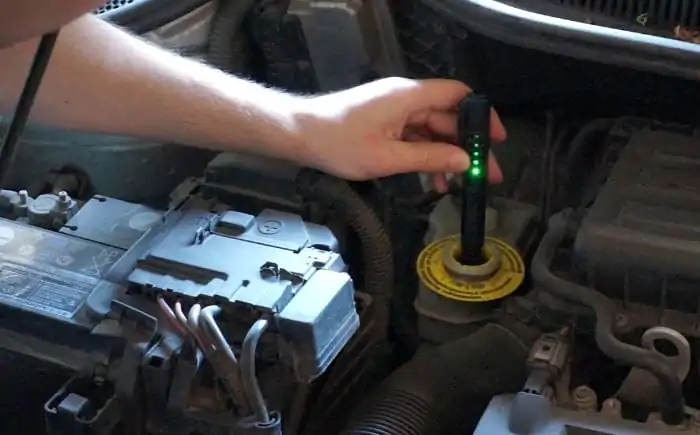
Price of brake fluid quality tester
The cost of a budget refractometer is in the range of 5-7 dollars. For diagnosis in a domestic environment, it will be enough. Check such a device for accuracy can be as follows.
On kitchen (or jewelry) scales, 50g is measured. "Dry" (fresh, taken from the canister) brake fluid. A tester placed in it will show 0%. One percent water (0,5 g) is added with a regular syringe. After each addition, the tester should show 1% (0,5g. Of water); 2% (1,0g. Of water); 3% (1,5g. Of water); 4% (2,0g. Of water).
Most often, cheap refractometers have sufficient accuracy to check the quality of TJ in a car in a domestic environment. More expensive models are used in service centers to finely measure fluid quality. The price of such devices varies from 40 to 170 cu For ordinary household measurements, this accuracy is not required, so a simple marker tester is enough.
Checking brake fluid with test strips
There is another budget option for measuring the quality of TJ. You can use test strips for this. They are impregnated with a special chemical that reacts with the liquid. They act on the principle of litmus test.
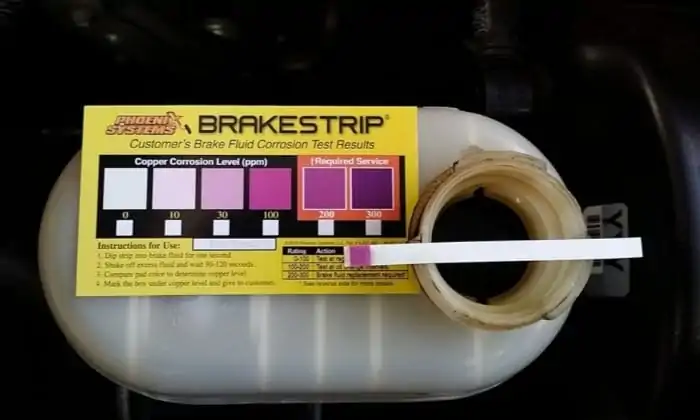
To perform the check, it is necessary to open the tank at the GTZ, unpack the strip and lower it into the liquid for about a minute. This time is sufficient for the formation of a chemical reaction. The strip will change color. This indicator is compared with the sample on the package.
How to change brake fluid?
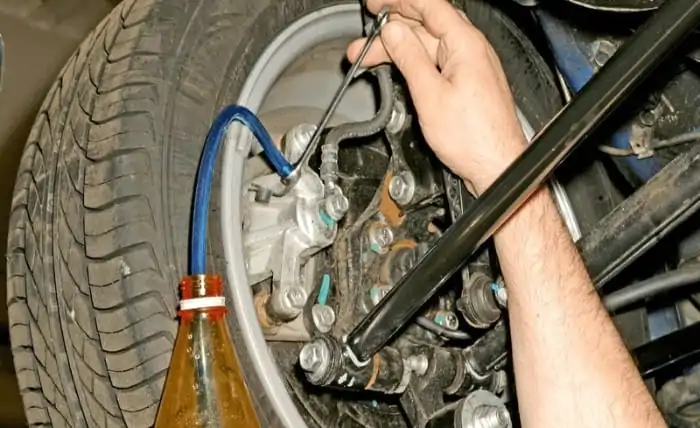
If the diagnosis showed the need for servicing the brake system, then pumping is carried out in the following sequence.
- Clarify which TJ standard the manufacturer of this vehicle recommends (most often it is DOT4). On average, a liter container is enough to completely replace a substance.
- Jack the rear right (in the direction of the car) part and remove the wheel.
- Lower the car to a support so that the suspension is at the normal level when the car is on all wheels.
- Release the bleeder valve (it is better to do this with a ring wrench or a head, rather than a spanner, so as not to break the edges). If the thread is “caked”, then you can use penetrating grease (for example, WD-40). Starting from this stage, one cannot do without an assistant. He must use a syringe to pump TG out of the reservoir over the GTZ, then fill it with new fluid.
- A transparent tube is put on the bleeder fitting (suitable from a dropper), on the other hand a syringe is put on it (or it is lowered into a container).
- The assistant starts the car, depresses the brake pedal and holds it in this position. At this moment, the fitting is carefully unscrewed half a turn. Part of the old fluid is pumped into the syringe. The fitting is twisted. The procedure is repeated until fresh fluid enters the syringe.
- The wheel is put in place.
- The same actions are performed with the rear left wheel and front right. Bleeding the brake system should be completed on the driver's side.
- Throughout the procedure, it is necessary to monitor the level of brake fluid so that air does not enter the system.
Since brake fluid has a complex chemical composition, it must be disposed of as hazardous waste (it must not be thrown into a garbage container or poured on the ground, but contact the appropriate service).
How often do I need to change brake fluid?
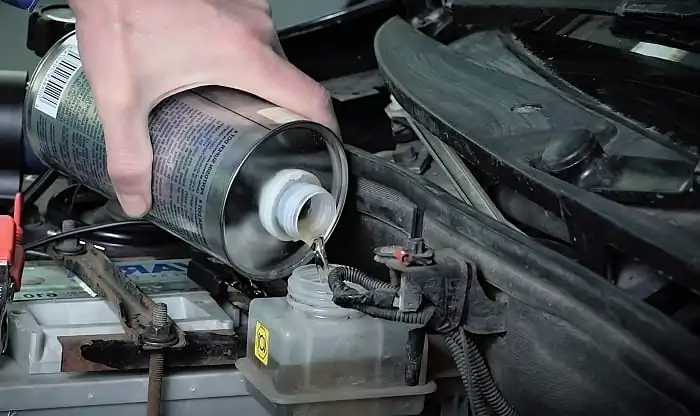
The figures for the frequency of replacement of TJ are not taken from the head, they are regulated by the manufacturer, based on its composition and properties. Most often, the change of TJ is carried out in the presence of 30-60 thousand kilometers.
But not only mileage affects the quality of the brake fluid. An important signal for its change is the color that can be determined using test strips. Experts recommend paying attention to the brake system as a whole. If it is depressurized, it is worth replacing the TG.
Common questions:
What is brake fluid for? Brake fluid is provided in every vehicle with a hydraulic braking system. Due to the closed brake circuit, the fluid pressure, when the brake pedal is pressed, allows the working cylinders to press the pads against the surfaces of the drums or discs.
How often do you need to change the brake fluid in your car? Every 2 years, regardless of mileage. Brake fluid is hygroscopic, which means it gradually accumulates moisture and loses its properties.
Why is it necessary to change the brake fluid? Like any technical fluid, the brake fluid contains an additive package that is exhausted over time. In this case, the brake fluid is gradually contaminated, its properties are lost until it boils.

